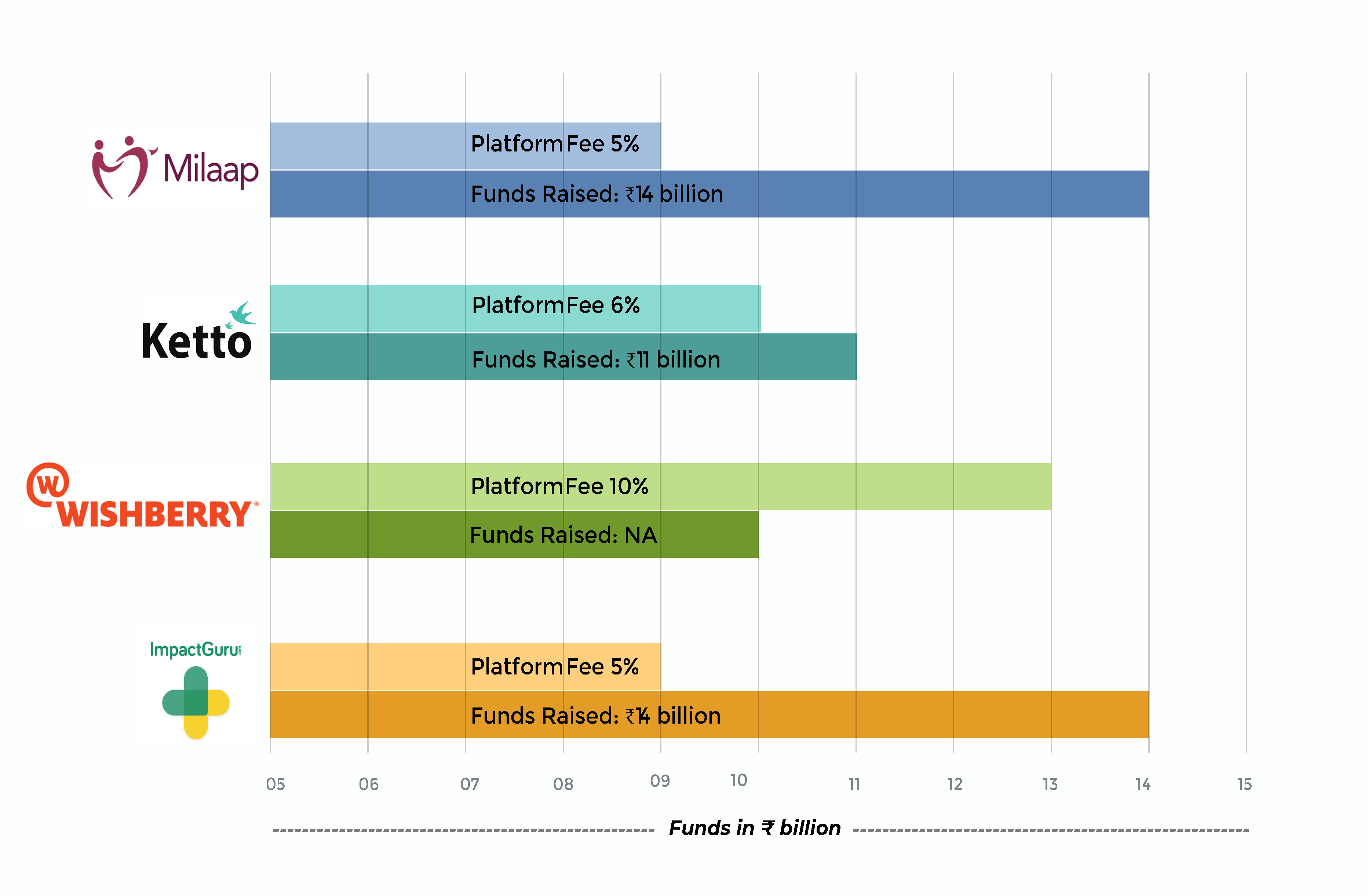We use cookies to make your experience better. To comply with the new e-Privacy directive, we need to ask for your consent to set the cookies. Learn more.
Donation-based Digital Crowdfunding—The Changing Face of Giving in India

Social-media and digital platforms are transforming lives like never before and crowdfunding is increasingly emerging as the new way to use these as tools to survive and thrive in challenging times. From calling for help to survive a life-threatening condition, to executing a business idea with funds from strangers, or funding higher studies abroad, to raising funds for the less fortunate during the prolonged pandemic, the power of people has never been so well-defined as it is now via crowdfunding platforms. These digital platforms are making lives easier for those in need and in numerous ways possible.
Philanthropy in India—An Age-Old Tradition
Sharing is caring. For a majority of Indians, much before crowdfunding—wherein like-minded strangers come together to raise funds for a business venture or a charitable cause, gained prevalence, the act of sharing or donating to those in need has been a cultural practice. Family philanthropy is known to have been practiced even during the Independence movement in India when some prominent business families made generous contributions to support social causes in the country. Many of them have continued to do so till date. According to HURUN India Philanthropy Report[1] 2020, some of the prominent families in philanthropy currently include that of Azim Premji of Wipro that donated ₹91.43 billion between 2018-2020, Shiv Nadar and family of HCL that donated ₹23.91 billion during the same period, while Mukesh Ambani and family of Reliance Industries donated ₹12.97 billion during 2018-2020.
India Philanthropy Report[2] states that philanthropy continues to grow in the country. In fiscal year 2020, private sector funding towards philanthropic causes totalled about ₹640 billion—close to 23% more than fiscal year 2019 (₹520 billion).
India has a substantial list of high-net-worth individuals who also happen to be generous philanthropists. As per the same HURUN Report, India’s philanthropy statistics are at a record high with the number of individuals who donated more than ₹100 million increasing by 100% over the last two years from 37 to 80 in 2020.
With 79% of donations, education remained the most favoured philanthropic cause followed by healthcare (5%) and disaster relief and management (3%) in 2020.
List of Favoured Philanthropic Causes of 2020
|
Donors/Donor families |
Cause |
Total Donation (INR in billion) |
|---|---|---|
| Azim Premji & family | Education | ₹93.24 billion |
| AM Naik | Healthcare | ₹7.53billion |
| Mukesh Ambani & family | Disaster Relief & Management | ₹3.59 billion |
| Shiv Nadar & family | Rural Transformation | ₹2.74 billion |
| Azim Premji & family | Environment & Sustainability | ₹1.81 billion |
| Rahul Bajaj & family | Livelihood Enhancement | ₹1 billion |
| Nandan Nilekani | Societal Platforms | ₹1.08 billion |
| Mukesh Ambani & family | Sports for Development | ₹0.63 billion |
Source: Based on the EdelGive Hurun India Philanthropy Report 2020
In fact, one of the few positive outcomes of the ongoing COVID-19 pandemic is that it highlighted the caring side of millions who helped those struggling on account of loss of livelihood or loss of loved ones due to the deadly coronavirus.
As per a report[3] by CAF India, globally, more people reported that they helped a stranger in 2020 (54.9%) than was ever recorded before in the CAF World Giving Index. More people donated money in 2020 than in the last five years (31.2%). The report further states that India is now in the top 20 most generous countries in the world, at 14th position in the same list.
Crowdfunding: A New Way to Give
While giving in India continues, new ways of giving have evolved too. These include crowdfunding, birthday and anniversary fundraisers, community events for raising funds for social causes, etc. However, usage of digital technology and increased internet penetration have made crowdfunding one of the most preferred or ‘go-to’ alternative—be it for raising funds for a start-up idea or fundraising for a personal cause such as meeting education costs, medical emergencies, social causes, etc.
A report[4] by Statista points out that China tops the list of countries which achieved the maximum transaction value for crowdfunding projects in the world in 2020, followed by the USA and the UK. India ranks sixth after Canada at US$ 1.8 million. As per the same report, in 2019, the global crowdfunding market was valued at US$ 13.9 billion and was forecasted to increase threefold by 2026.
Rise of Digital Platforms Supporting the Act of Giving
India witnessed the birth of a new breed of digital platforms to support giving in the early years of the last decade, with the emergence of Milaap in 2010, followed by Ketto and Wishberry in 2012. Since then, there has been a steady increase in the number of these donating platforms. ImpactGuru, which was incubated in Harvard Innovation Labs' Venture Initiation Program in the USA, started its journey in India in 2014.
However, it was only in 2020 that a majority of these platforms saw a huge spurt in their activities during the COVID-19 crisis. Ketto, Milaap, and ImpactGuru saw a significant surge in online donations since the second wave of the pandemic intensified in the country.

Source: Based on data from company websites
Sample this: In 2020, Milaap, collected nearly ₹900 million which was used to help stranded migrants and daily wage labourers to get access to essentials and community kitchens. A company statement released to the media[5] said that in April 2020 alone, they witnessed an increase in customer queries by five times and a 65% increase in the number of fundraisers. Most number of fundraisers were for organising meals and ration for the worst-affected segments including daily wage earners and migrant workers, followed by funds for medical and personal protective equipment for healthcare and other frontline workers. The third most popular fundraisers were for raising capital for specifically vulnerable segments of the society.
Ketto,[6] another homegrown crowdfunding platform, raised over ₹1.15 billion through its campaigns related to COVID-19 and registered a four times growth during the lockdown. ImpactGuru saw donations double per minute post COVID-19 averaging 2.5 donations every minute.
One of the biggest driving forces behind the success of donation-based crowdfunding platforms is the pull of social media. With stories of despair pouring in on popular social media platforms such as Facebook, Instagram and Twitter, from all quarters of the country during this pandemic, people extended all the help to those in need like never before.
For instance, an 11-year-old girl from Hyderabad[7] sought donations for raising funds to provide ration kits to daily wage workers. Following her pleas on social media via one of the crowdfunding platforms, she received generous contributions to the tune of ₹800,000 from across the globe.
A report[8] released by PayU, one of the leading online payments solution providers, in June, stated that the online donations to charitable causes touched an all-time high in lockdown 2.0 (in 2021). Digital payments for charitable causes witnessed a massive 731% increase in the number of transactions, a 2,308% increase in expenditure, and a 128% increase in average ticket size vis-a-vis pre-lockdown months in 2021, the report added. Let us look at how these crowdfunding platforms work and act as a catalyst in making a difference in the lives of others.
Understanding the Business Model: Is it All for a ‘Just-Cause’?
Donation-based crowdfunding is all about raising funds from individuals to support personal or social causes with no financial returns for the contributors. The only tangible gain for a contributor on a donation-based crowdfunding platform is the tax benefit one can claim under Section 80G of the Income Tax Act based on the terms and conditions of the platform being used. In India, crowdfunding is governed by the Securities and Exchange Board of India (SEBI). In June 2014, SEBI issued a “Consultation Paper on Crowdfunding in India” which discusses legal and regulatory challenges in implementing the framework for crowdfunding.
So why use digital platforms for giving? First, is the reach. Digital platforms can connect those in need of help to those willing to help, in a matter of a few minutes. In the era of smartphones and fast-paced digital technologies, a donor sitting in another country can also be reached out for monetary help within minutes. For instance, Milaap’s Facebook page has over two million followers and its donors are spread over 130 countries. At the click of a button, one can donate for a cause close to one’s heart.
Second, donating through a digital platform is safe, hassle-free and is transparent to a large extent, if not completely. The ability to measure and track a fundraising campaign and its results is far more precise for online fundraising activities than for offline ones. The digital platforms keep all the donors well-informed at every stage via social media platforms as the campaign progresses. Knowing that a cause you donated for, was all worth it in the end, is the highest form of satisfaction that one can get.
Third, ease of starting a campaign is available only on digital platforms. In about five minutes, you can start a fundraiser of your own and begin to share it across social media platforms. Quick approvals from other stakeholders such as hospitals, educational institutions which are also involved, further speed up the fundraising process.
Owing to the prolonged COVID-19 pandemic, a majority of these key players have waived off their platform fee and are allowing citizens in need for medical support and healthcare to run their campaigns for free. These include Ketto, ImpactGuru and Milaap which are now charging a premium fee only for customised and value-added services such as assisting and collaborating for running multimedia campaigns, providing high-touch customer support, customised outreach plans for a fruitful fundraising experience. This is a humongous task if one were to start a campaign offline and expect the same results.
Roadblocks on the Way of a Fruitful Campaign
Even though digital platforms provide ease of raising capital and faster turnaround time, these are not devoid of their own share of challenges. Here are some of the roadblocks in leveraging the benefits of crowdfunding for a cause:
Trust deficit and mismatched expectations: One of the biggest impediments in the way of donation-based crowdfunding platforms is the trust factor. Often the expectations of the donors and their experiences vis-à-vis their chosen platform are mismatched leading to failure of the campaign and loss of reputation for the platform. How the funds raised are being utilised by the end-user is often ambiguous.
Data safety and privacy issues: Even though technology and secure payment gateways are the backbone of the crowdfunding platforms, yet, threats pertaining to data safety and privacy of the contributors are present. Despite multiple layers of security and assurances around data not being shared with third parties, more often than not, these crowdfunding platforms are susceptible to data breaches similar to those as on the e-commerce websites. To mitigate such risks, SEBI included public safety in its regulations for crowdfunding.
Time-consuming campaigns: As the campaign progresses, it involves generating steady momentum by tweaking social media pitches and launching regular updates, responding to questions and suggestions from donors, keeping social media activities up and running and trying to win as much support as you can in due time. Until your campaign target is within reach, the pressure is constantly on doing more of everything. There have been instances of delay in raising money in case of rare diseases and illnesses and by the time funds arrive, sadly, the patient is no more.
The Way Ahead
Crowdfunding, more specifically donation-based crowdfunding, is here to stay as a means for mobilising resources for those in need. However, donation-based crowdfunding is largely out of the ambit of the regulatory guidelines as framed by SEBI. As per a paper published in the Journal of Risk and Financial Management,[9] increasing technological awareness necessitates designing new regulations by the concerned government authorities that govern the crowdfunding platforms and the entities seeking funding on those platforms. Government authorities need to set up statutes and regulations that will keep all the stakeholders such as crowdfunding platforms, NGOs, and individuals accountable after the campaign has ended. This is especially an issue in India, where regulatory authorities are still responding to the crowdfunding boom. So far, we are only getting started to see the ways in which it can transform lives.
[1] Hurun Report - Info - Hurun India Philanthropy List 2020. (n.d.). www.hurun.net. Retrieved August 12, 2021, from https://www.hurun.net/en-US/Info/Detail?num=J1RIWTAVLKMO
[2] Sheth, A. India Philanthropy Report 2021. Bain. Retrieved from https://www.bain.com/insights/india-philanthropy-report-2021/
[3] World giving index 2021 Focus on India.(n.d.). https://www.cafindia.org/images/WGI/WGI_Trend_analysis_India.pdf
[4]Thrive with the crowd - Times of India. (n.d.). The Times of India. https://timesofindia.indiatimes.com/business/international-business/thrive-with-the-crowd/articleshow/75313310.cms
[5] Bureau, O. (n.d.). Milaap crowdsources Rs 90 crore for Covid relief. @Businessline. Retrieved from https://www.thehindubusinessline.com/info-tech/crowfunding-platform-milaap-raises-rs-90-cr-to-help-migrant-workers/article31540574.ece
[6] How crowdfunding is transforming lives. (n.d.). The Economic Times. Retrieved from https://economictimes.indiatimes.com/small-biz/sme-sector/how-crowdfunding-is-transforming-lives/articleshow/82213708.cms
[7] Reporter, S. (2020, April 15). Girl raises ₹6.2 lakh for the needy. The Hindu. https://www.thehindu.com/news/cities/Hyderabad/girl-raises-62-lakh-for-the-needy/article31342216.ece
[8] Livemint Online donations to charitable causes touch all-time high in lockdown 2.0. Mint. Retrieved from https://www.livemint.com/news/india/online-donations-to-charitable-causes-touch-all-time-high-in-lockdown-20-11624361126928.html
[9] Khurana, I. (2021). Legitimacy and Reciprocal Altruism in Donation-Based Crowdfunding: Evidence from India. Journal of Risk and Financial Management, 14(5), 194. https://doi.org/10.3390/jrfm14050194





